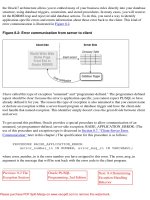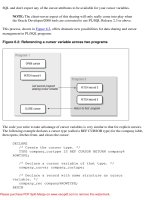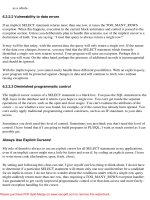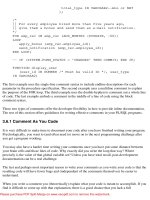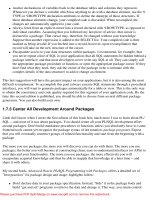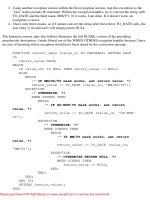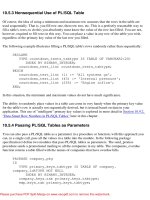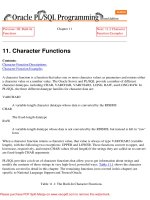o'reilly - oracle sql plus pocket reference 2nd edition
Bạn đang xem bản rút gọn của tài liệu. Xem và tải ngay bản đầy đủ của tài liệu tại đây (827.33 KB, 56 trang )
•
Tabl e o f
Contents
• Index
• Reviews
•
Reader
Reviews
• Errata
Oracle SQL*Plus Pocket Reference, 2nd Edition
By Jonathan Gennick
Publisher : O'Reilly
Pub Date : October 2002
ISBN : 0-596-00441-9
Pages : 120
Copyright
Oracle SQL*PlusPocket Reference
Section 1.1. Introduction
Section 1.2. Interacting with SQL*Plus
Section 1.3. Selecting Data
Section 1.4. Inserting Data
Section 1.5. Updating Data
Section 1.6. Deleting Data
Section 1.7. Merging Data (Oracle9i)
Section 1.8. Transaction Management
Section 1.9. Formatting Text Reports
Section 1.10. Tuning SQL
Section 1.11. SQL*Plus Format Elements
Oracle SQL*PlusPocket Reference
Section 1.1. Introduction
Section 1.2. Interacting with SQL*Plus
Section 1.3. Selecting Data
Section 1.4. Inserting Data
Section 1.5. Updating Data
Section 1.6. Deleting Data
Section 1.7. Merging Data (Oracle9i)
Section 1.8. Transaction Management
Section 1.9. Formatting Text Reports
Section 1.10. Tuning SQL
Section 1.11. SQL*Plus Format Elements
1.1 Introduction
The Oracle SQL*Plus Pocket Reference is a quick-reference guide to SQL*Plus and to commonly
used SQL query and data manipulation statements. The purpose of this book is to help you find the
syntax of specific language elements. It is not a self-contained user guide; basic knowledge of
SQL*Plus is assumed. For more information, see my book Oracle SQL*Plus: The Definitive Guide
(O'Reilly) and Mastering Oracle SQL by Sanjay Mishra and Alan Beaulieu (O'Reilly).
1.1.1 Acknowledgments
Deborah Russell, Darl Kuhn, Ken Jacobs, and Alison Holloway all played a part in making this book
a reality. For their assistance and support, I'm most grateful.
1.1.2 Conventions
UPPERCASE
Indicates SQL*Plus, SQL, or PL/SQL keywords
lowercase
Indicates user-defined items such as table names
Italic
Indicates filenames, emphasis, introduction of new terms, and parameter names
Constant width
Used for code examples
Constant width bold
Indicates user input in examples showing an interaction
[ ]
Used in syntax descriptions to denote optional elements
{ }
Used in syntax descriptions to denote a required choice
|
Used in syntax descriptions to separate choices
_
Used in syntax descriptions to indicate that the underlined option is the default
1.2 Interacting with SQL*Plus
This section covers essential information you need to know to interact with SQL*Plus. Here you will
learn how to start SQL*Plus, enter commands, delimit strings, and name variables.
1.2.1 Starting SQL*Plus
Invoke SQL*Plus by issuing the sqlplus command from your operating-system command prompt.
On Microsoft Windows systems, use either sqlplus or sqlplusw depending on whether you want
SQL*Plus to run in a command-prompt window or in its own window; you can also select an icon
from the Start menu. (Early releases of SQL*Plus on Windows used executable names such as
PLUS33 and PLUS80W.)
Beware of passing your password as a command-line argument to
SQL*Plus. Such passwords may be easily visible to other users on Linux
and Unix systems.
1.2.1.1 Syntax for the sqlplus command
The syntax used to invoke SQL*Plus is as follows:
sqlplus [[-S[ILENT]] [-H[ELP]] [-V[ERSION]]
[-R[ESTRICT] level] [-L[OGON]]
[-M[ARKUP] "markup_options"]
[ [username[/password][@connect]|/
[AS {SYSDBA|SYSOPER}]]
|/NOLOG]
[@scriptfile [arg1 arg2 arg3 ]]]
The -RESTRICT and -MARKUP parameters are new in Oracle8i. -HELP and -VERSION are new
in Oracle9i. Here are the parameter descriptions:
-S[ILENT]
Tells SQL*Plus to run in silent mode. No startup message is displayed; no command
prompt is displayed; no commands are echoed to the screen.
-H[ELP]
Causes SQL*Plus to display a short summary of this syntax. Prior to Oracle9i, use sqlplus -
to get the help summary.
-V[ERSION]
Causes SQL*Plus to display version and copyright information. Prior to Oracle9i, use
sqlplus -? to get version and copyright information.
-R[ESTRICT] level
Restricts what the user can do from SQL*Plus. The level must be one of the following:
1
Disables the EDIT, HOST, and ! commands
2
Disables the EDIT, HOST, !, SAVE, SPOOL, and STORE commands
3
Disables the EDIT, GET, HOST, !, SAVE, START, @, @@, SPOOL, and STORE
commands
Level 3 also disables the reading of the login.sql file. The glogin.sql file is read, but
restricted commands aren't executed.
-L[OGON] (new in Oracle9i Release 9.2)
Prevents SQL*Plus from reprompting for the username and password in the event that the
first username and password passed is incorrect.
-M[ARKUP] markup_options
Allows you to specify the markup language to use when generating output. Except for
HTML, all markup options are optional. The following are valid markup options. Default
values are underlined or noted in the text.
HTML {ON | OFF}
Specifies the markup language to use and enables or disables the use of that markup
language. You must specify a value for this option.
HEAD text
Specifies content for the <head> tag. The tag is written as <head>text</head>.
BODY text
Specifies attributes for the <body> tag. The tag is written as <body text>.
TABLE text
Specifies attributes for the <table> tag that formats query output. The tag is written as
<table text>.
ENTMAP {ON | OFF}
Controls whether SQL*Plus uses HTML equivalents such as < and > for special
characters such as "<" and ">".
SPOOL {ON | OFF}
Controls whether SQL*Plus writes <html>, <head>, and <body> tags to any spool file you
create during your SQL*Plus session, while HTML is ON.
PRE[FORMAT] {ON | OFF}
Controls whether query output is enclosed within <pre> </pre> tags rather than within
HTML tables.
On some operating systems, you need to enclose the entire string of markup options within
double quotes. For example:
sqlplus -m "html on spool off"
Furthermore, any HEAD, BODY, and TABLE text should itself be quoted, and you must
escape the quotes:
sqlplus -m "html on table \"width=50% align='left'\""
The backslash-quote (\") syntax works on Windows XP, Linux, and Unix, and places a
quote (
") within the string that is the value for the -M option.
username [/password][@connect]
Your database login information. connect is an Oracle Net connect identifier such as those
defined in $ORACLE_HOME/network/admin/tnsnames.ora.
/
Connects you to a local database using operating-system authentication.
AS {SYSDBA | SYSOPER}
Connects you in an administrative role so that you can perform database administration
tasks (e.g., starting and stopping a database instance). You may need to enclose the login
within quotes:
sqlplus "sys/password as sysdba"
/NOLOG
Tells SQL*Plus to start without connecting to a database first.
scriptfile
The name of a SQL*Plus script file. SQL*Plus will start up and then execute the file.
Beginning in Oracle9i, you may also specify the URL of a file. See
At Sign (@)
for an
example of this.
arg1 agr2 arg3
Optional command-line arguments to pass to your script. Separate arguments by at least one
space.
1.2.2 Entering Commands
How you enter commands in SQL*Plus depends on whether you are entering a command to
SQL*Plus itself, or are entering a SQL statement or a PL/SQL block.
1.2.2.1 Entering SQL*Plus commands
Commands such as DESCRIBE, COLUMN, TTITLE, SET, and all the others listed in SQL*Plus
Command Reference are commands to SQL*Plus itself. These must be entered on one line and are
executed immediately after you enter them. For example:
SET ECHO ON
DESCRIBE employee
SQL*Plus commands may optionally be terminated by a semicolon. For example:
PROMPT This semicolon won't print.;
CONNECT system/manager;
You can change this behavior of SQL*Plus towards semi-colons by changing the
SQLTERMINATOR setting.
Long SQL*Plus commands may be continued onto multiple physical lines. The SQL*Plus
continuation character is a hyphen (
-). Use it at the end of a physical line to continue a long
SQL*Plus command to the next line. The following three lines, for example, are treated as one by
SQL*Plus:
COLUMN employee_id -
FORMAT 099999 -
HEADING 'Emp ID'
The space in front of the continuation character is optional. Quoted strings may also be continued.
For example:
SELECT 'Hello-
World!' FROM dual;
When you continue a quoted string, any spaces before the continuation character are included in the
string. The line break also counts as one space.
1.2.2.2 Entering SQL statements
SQL statements may span multiple lines and must always be terminated. This may be done using
either a semicolon (
; ) or a forward slash ( / ). For example:
SELECT user
FROM dual;
SELECT user
FROM dual
/
In both cases, the SQL statement is entered into a buffer known as the SQL buffer and is then
executed. You may also terminate a SQL statement using either a blank line or a period, in which
case the statement is stored in the buffer but not executed. For example:
SQL> SELECT user
2 FROM dual
3
SQL> SELECT user
2 FROM dual
3 .
Use the SET SQLTERMINATOR command to change the terminator from a semicolon to some
other character. Use SET SQLBLANKLINES ON to allow blank lines within a SQL statement. To
execute the statement currently in the buffer, enter a forward slash on a line by itself.
1.2.2.3 Entering PL /SQL blocks
PL/SQL blocks may span multiple lines and may contain blank lines. They must be terminated by
either a forward slash or a period (
.) on a line by itself. For example:
BEGIN
DBMS_OUTPUT.PUT_LINE('Hello World!');
END;
/
BEGIN
DBMS_OUTPUT.PUT_LINE('Hello World!');
END;
.
When a forward slash is used, the block is sent to the server and executed immediately. When a
period is used, the block is stored only in the SQL buffer. Use the SET BLOCKTERMINATOR
command to change the block terminator from a period to some other character.
1.2.3 Strings in SQL*Plus Commands
Many SQL*Plus-specific commands take string values as parameters. Simple strings containing no
spaces or punc-tuation characters may be entered without quotes. Here's an example:
COLUMN employee_id HEADING emp_id
Generally, it's safer to use quoted strings. Either single or double quotes may be used. For example:
COLUMN employee_id HEADING 'Emp #'
COLUMN employee_id HEADING "Emp #"
To embed quotes in a string, either double them or use a different enclosing quote. The following
two commands have equivalent results:
COLUMN employee_id HEADING '''Emp #'''
COLUMN employee_id HEADING "'Emp #'"
The single exception to these rules is the PROMPT command. All quotes used in a PROMPT
command will appear in the output.
1.2.4 Specifying Filenames
Several SQL*Plus commands allow you to specify a file-name. In all cases, you may also include a
path and/or an extension with the name. For example:
SPOOL my_report
SPOOL c:\temp\my_report
SPOOL create_synonyms.sql
Most file-related commands assume a default extension if you don't supply one. The default varies
by command.
1.2.5 Naming Variables
SQL*Plus allows you to declare two types of variables: user variables and bind variables. The rules
for naming each type are different.
User variable names may contain letters, digits, and underscores ( _ ) in any order. They are case-
insensitive and are limited to 30 characters in length.
Bind variable names must begin with a letter but after that may contain letters, digits, underscores,
dollar signs (
$), and number signs (#). They also are case-insensitive and are limited to 30
characters in length.
1.3 Selecting Data
The SELECT statement is the key to getting data out of an Oracle database. It's also very likely the
most commonly executed SQL statement from SQL*Plus.
1.3.1 The SELECT Statement
The basic form of the SELECT statement looks like this:
SELECT column_list
FROM table_list
WHERE conditions
GROUP BY column_list
HAVING conditions
ORDER BY column_list;
The lists in this syntax are comma-delimited. The column list, for example, is a comma-delimited list
of column names or expressions identifying the data you want the query to return.
1.3.1.1 Selecting columns from a table
To retrieve columns from a table, list the columns you want after the SELECT keyword, place the
table name after the FROM keyword, and execute your statement. The following query returns a list
of tables you own with the names of their assigned tablespaces:
SELECT table_name, tablespace_name
FROM user_tables;
1.3.1.2 Ordering query results
You can use the ORDER BY clause to sort the results of a query. The following example sorts the
results by table name:
SELECT table_name, tablespace_name
FROM user_tables
ORDER BY table_name;
The default is to sort in ascending order. You can specify descending order using the DESC keyword.
For example:
ORDER BY table_name DESC;
While it's redundant, ASC may be used to specify ascending order. The following example sorts the
table list first by tablespace name in descending order and then within that by table name in
ascending order:
SELECT table_name, tablespace_name
FROM user_tables
ORDER BY tablespace_name DESC,
table_name ASC;
If you want the sort to be case-insensitive, you can use Oracle's built-in UPPER function. For
example:
SELECT table_name, tablespace_name
FROM user_tables
ORDER BY UPPER(table_name);
For symmetry, Oracle also has a built-in LOWER function. LOWER converts a string to lowercase;
UPPER converts to uppercase.
1.3.1.3 Restricting query results
Use the WHERE clause to restrict the rows returned by a query to those that you need to see. The
following example returns a list of any invalid objects that you own:
SELECT object_name, object_type
FROM user_objects
WHERE status = 'INVALID'
ORDER BY object_type, object_name;
The expression following the WHERE clause may be any valid Boolean expression. Oracle supports
all the typical operators you'd expect: +, -, /, *, <, >, <>, <=, >=, AND, OR, NOT, ||, IS NULL,
LIKE, BETWEEN, and IN. Parentheses are also supported and may be used to clarify the order of
evaluation.
1.3.1.4 Using column aliases
If a SELECT statement includes columns that are expressions, Oracle generates a column name
based on the expression. Take a look at the following SQL statement:
SELECT SUM(hours_logged)
FROM project_hours
WHERE project_id = 1001;
The name of the column returned by this query will be SUM(HOURS_LOGGED). That means that
any COLUMN commands used to format the output need to look like this:
COLUMN SUM(HOURS_LOGGED) -
HEADING 'Total Hours'
As your expressions become more complicated, the Oracle-generated names become difficult to deal
with. It's better to use a column alias to supply a more user-friendly name for the computed column.
For example:
SELECT SUM(hours_logged) total_hours
FROM project_hours
WHERE project_id = 1001;
Now the column name is obvious. It's TOTAL_HOURS, and it won't change even if the expression
changes.
1.3.2 Null Values
Null values are pernicious, especially in the WHERE clause of a query. With only a few exceptions,
any expression containing a null value returns a null as the result. Because nulls are considered
neither true nor false, this can have unexpected ramifications in how a WHERE clause is evaluated.
Consider the following query that attempts to retrieve a list of NUMBER columns with a scale other
than 2:
SELECT table_name, column_name
FROM user_tab_columns
WHERE data_type = 'NUMBER'
AND data_scale <> 2;
This query is an utter failure because it misses all the floating-point NUMBER columns that have no
scale defined at all. Avoid this problem by explicitly considering nulls when you write your WHERE
clause. Use either the IS NULL or the IS NOT NULL operator. For example:
SELECT table_name, column_name
FROM user_tab_columns
WHERE data_type = 'NUMBER'
AND (data_scale <> 2
OR data_scale IS NULL);
When sorting data, null values are treated as greater than all other values. When a standard
ascending sort is done, null values sort to the bottom of the list. A descending sort causes null values
to rise to the top. You can use the built-in NVL or COALESCE (Oracle9i) functions to modify this
behavior.
1.3.2.1 Using the NVL function
If you wish to return results from a query that might be null or sort on results that might be null, you
can use Oracle's built-in NVL function to replace null values with a selected non-null value. For
example, the NUM_ROWS column in the USER_TABLES view has a value only for tables that
have been analyzed. Here, the NVL function converts null values to zeros:
SELECT table_name, NVL(num_rows,0)
FROM user_tables
ORDER BY NVL(num_rows,0);
Be cautious about using NVL in a WHERE clause. Using NVL, or any other function, on an indexed
column in a WHERE clause may prevent Oracle from using any index on that column.
1.3.2.2 Using the COALESCE function
New in Oracle9i, the COALESCE function extends the concept behind NVL. You can pass in any
number of values as parameters, and COALESCE returns the first non-null value as its result.
Consider this nested NVL invocation:
SELECT NVL(employee_nickname,
NVL(employee_first_name,
employee_last_name))
FROM employee;
The nesting of the calls to NVL makes it difficult to decipher the goal of this query. In Oracle9i, you
can write the query much more simply using the COALESCE function:
SELECT COALESCE(employee_nickname,
employee_first_name,
employee_last_name)
FROM employee;
This query returns each employee's nickname. If there is no nickname for an employee, then the first
name is returned instead. If there is no first name, the last name is returned. COALESCE makes this
order of preference much more obvious than in the previous NVL solution.
If all parameters to COALESCE are null, the function returns a null result. You can avoid a null
result by making your final parameter a constant rather than a column name.
1.3.3 CASE Expressions
CASE expressions represent an ANSI-standard mechanism for embedding IF THEN ELSE logic
in a SQL statement. Prior to the introduction of CASE, you had to use the Oracle-specific DECODE
function to implement conditional logic in a SQL statement. CASE expressions may be used in
select lists, WHERE clauses, HAVING clauses, and anywhere else an expression is valid.
CASE was introduced in Oracle8i but was enhanced in Oracle9i by the
addition of searched CASE expressions. I've heard reports that in Release
8.1.7, CASE did not work from PL/SQL.
1.3.3.1 Simple CASE expressions
Simple CASE expressions are closest in concept to the DECODE function. The general form is:
CASE expression
WHEN expression_1 THEN return_expression_1
WHEN expression_2 THEN return_expression_2
ELSE return_expression
END
The ELSE portion of the CASE expression is optional. The following is an example of a simple
CASE expression:
SELECT course_name,
CASE period
WHEN 1 THEN 'First'
WHEN 2 THEN 'Second'
WHEN 3 THEN 'Third'
WHEN 4 THEN 'Fourth'
WHEN 5 THEN 'Fifth'
ELSE 'Unknown'
END period_name
FROM course;
The period_name following the END keyword is a column alias. It's not necessary, but when using
SQL*Plus, it's sometimes helpful to name columns that are the result of an expression.
The equivalent DECODE expression is as follows:
SELECT course_name,
DECODE(period,1,'First',2,'Second',3,'Third',
4,'Fourth',5,'Fifth',
'Unknown') period_name
FROM course;
CASE is part of the SQL standard, whereas DECODE is not. Thus, the use of CASE is preferable
when you have a choice.
1.3.3.2 Searched CASE expressions
A searched CASE expression allows you to do more than match on a single value. A searched CASE
allows you to match on expressions:
SELECT course_name,
CASE WHEN period >= 1
AND period <= 3 THEN 'Morning'
WHEN period >= 4
AND period <= 6 THEN 'Afternoon'
ELSE 'After School'
END
FROM course;
Searched CASE expressions are versatile, and enable you to easily do things that were previously
difficult or impossible to do.
1.3.4 Table Joins (Oracle8i)
It's very common to combine data from two or more tables to return related information. Such a
combination of two tables is referred to as a join.
You join two tables by listing them in the FROM clause, separated by commas. For example:
SELECT user_constraints.constraint_name,
user_constraints.constraint_type,
user_cons_columns.column_name
FROM user_constraints, user_cons_columns;
This query returns the Cartesian product 뾞 ll possible combinations of all rows from both tables.
Conceptually, this is where all joins start. In practice, you almost always put some conditions in the
WHERE clause so that only related rows are combined. The following, more useful, query returns a
list of constraint names together with the columns involved in each constraint:
SELECT user_constraints.constraint_name,
user_constraints.constraint_type,
user_cons_columns.column_name
FROM user_constraints, user_cons_columns
WHERE user_constraints.constraint_name
= user_cons_columns.constraint_name;
Because both tables contain columns with matching names, the column references must be qualified
with the table name. You can see that this quickly gets cumbersome. The solution is to provide a
shorter alias for each table and use that alias to qualify the column names. For example:
SELECT uc.constraint_name,
uc.constraint_type,
ucc.column_name
FROM user_constraints uc,
user_cons_columns ucc
WHERE uc.constraint_name =
ucc.constraint_name;
Here, the alias uc is used for the USER_CONSTRAINTS table, while UCC is used for
USER_CONS_COLUMNS. The resulting query is much easier to read because you aren't
overwhelmed with long table names.
1.3.4.1 Inner and outer joins
The joins that you've seen so far are inner joins. An inner join is one that returns data only when
both tables have a row that matches the join conditions. For example, the following query returns
only tables that have constraints defined on them:
SELECT ut.table_name, uc.constraint_name
FROM user_tables ut, user_constraints uc
WHERE ut.table_name = uc.table_name;
An outer join returns rows for one table, even when there are no matching rows in the other. You
specify an outer join in Oracle by placing a plus sign (+) in parentheses following the column names
from the optional table in your WHERE clause. For example:
SELECT ut.table_name, uc.constraint_name
FROM user_tables ut, user_constraints uc
WHERE ut.table_name = uc.table_name(+);
The (+) after uc.table_name makes the user_constraint table optional. The query returns all tables,
and where there are no corresponding constraint records, Oracle supplies a null in the constraint
name column.
1.3.5 Table Joins (Oracle9i)
Oracle9i introduces new table join syntax; this is the join syntax defined by the ANSI SQL/92
standard. Join conditions may now be written in the FROM clause, making it easier to follow the
logic of a query. In addition, the new syntax supports full outer joins, something not possible using
the old syntax. Unless you need to maintain compatibility with old releases of Oracle, I strongly
recommend using the new syntax.
1.3.5.1 Sample tables
Example queries in this section on Oracle9i table joins are based on the following three tables:
SQL> SELECT *
2 FROM course;
COURSE_NAME PERIOD
Spanish I 1
Spanish 1 6
U.S. History 3
English II 4
SQL> SELECT *
2 FROM enrollment;
COURSE_NAME PERIOD STUDENT_NAME
English II 4 Michael
Spanish I 1 Billy
Spanish I 6 Sky Lynn
Spanish I 1 Jeff
English II 4 Jenny
SQL> SELECT *
2 FROM student;
STUDENT_NAME GRADE
Michael 6
Billy 3
Sky Lynn 1
Jeff 1
Jenny 8
Note that Sky Lynn's enrollment record is without a matching COURSE record. She is registered for
Spanish I (letter "I"), while the course is Spanish 1 (digit "1"). This becomes significant when
performing an outer join and when using the new USING clause.
1.3.5.2 Inner joins
Use the INNER JOIN keywords in the FROM clause to specify an inner join between the two tables.
Use the ON clause to specify your join conditions. For example:
SELECT c.course_name, c.period, e.student_name
FROM course c INNER JOIN enrollment e
ON c.course_name = e.course_name
AND c.period = e.period;
Other clauses, such as WHERE and ORDER BY come after the FROM clause:
SELECT c.course_name, c.period, e.student_name
FROM course c INNER JOIN enrollment e
ON c.course_name = e.course_name
AND c.period = e.period
WHERE c.period < 9
ORDER BY c.period, c.course_name;
1.3.5.3 Join order
When joining more than two tables, use parentheses to control the join order. The following query
joins COURSE and ENROLLMENT first, and then joins the table named STUDENT to the result:
SELECT c.course_name, c.period, s.student_name, s.grade
FROM (course c INNER JOIN enrollment e
ON c.course_name=e.course_name
AND c.period=e.period)
INNER JOIN student s ON e.student_name=s.student_name;
If you omit parentheses, Oracle processes the joins from left to right. The example here uses
parentheses to explicitly specify the default join order.
1.3.5.4 Left and right outer joins
To perform an outer join of the type traditionally supported by Oracle, use either LEFT OUTER
JOIN or RIGHT OUTER JOIN. Left and right outer joins are similar; the difference lies in the
ordering of the tables in the FROM clause. The following query uses the old syntax to return all
rows from COURSE together with any matching rows from ENROLLMENT:
SELECT c.course_name, c.period, e.student_name
FROM course c, enrollment e
WHERE c.course_name = e.course_name(+)
AND c.period = e.period(+);
In this query, ENROLLMENT is considered the optional table because (+) is appended to each of
that table's columns. The following two queries accomplish the same join using the new, ANSI
standard syntax:
SELECT c.course_name, c.period, e.student_name
FROM course c LEFT OUTER JOIN enrollment e
ON c.course_name = e.course_name
AND c.period = e.period;
SELECT c.course_name, c.period, e.student_name
FROM enrollment e RIGHT OUTER JOIN course c
ON c.course_name = e.course_name
AND c.period = e.period;
Note the difference between the two queries. The first query lists the COURSE table first, while the
second query lists the ENROLLMENT table first. A LEFT OUTER JOIN makes the left table the
required table. A RIGHT OUTER JOIN makes the right table the required table. In both queries,
ENROLLMENT is the optional table, and COURSE is the required table.
1.3.5.5 Full outer joins
The full outer join represents a new capability in Oracle9i. A full outer join returns all rows from
both tables. Where possible, rows from one table are matched with those from the other. In Oracle8i,
you can simulate an outer join using a UNION query:
SELECT c.course_name, c.period, e.student_name
FROM course c, enrollment e
WHERE c.course_name = e.course_name(+)
AND c.period = e.period(+)
UNION
SELECT e.course_name, e.period, e.student_name
FROM enrollment e
WHERE NOT EXISTS (
SELECT *
FROM course c2
WHERE c2.course_name = e.course_name
AND c2.period = e.period
);
To execute this UNION query, Oracle needs to execute each SELECT statement separately and then
combine the results. You potentially can end up with two full table scans for each table. In Oracle9i,
you can use the FULL OUTER JOIN keyword to do the same thing:
SQL> SELECT c.course_name, c.period, e.student_name
2 FROM course c FULL OUTER JOIN enrollment e
3 ON c.course_name = e.course_name
4 AND c.period = e.period;
COURSE_NAME PERIOD STUDENT_NAME
English II 4 Michael
Spanish I 1 Billy
Spanish I 1 Jeff
English II 4 Jenny
Spanish 1 6
U.S. History 3
Sky Lynn
As you can see, this query is easier to understand than the UNION query. It is also one SELECT
statement and should execute more efficiently than the UNION query shown previously.
1.3.5.6 Specifying join conditions
Oracle9i supports three ways to specify join conditions: the ON, NATURAL, and USING clauses.
The most general approach is to use the ON clause, in which you can specify any type of join
condition. For example:
SELECT c.course_name, c.period, e.student_name
FROM course c FULL OUTER JOIN enrollment e
ON c.course_name = e.course_name
AND c.period = e.period;
This particular query is an equi-join; it looks for cases in which the corresponding columns from the
two tables contain the same values. Because the names of the join columns are identical in the two
tables, this join is also considered a natural join . Oracle supports the following shorthand syntax for
natural joins:
SELECT course_name, period, e.student_name
FROM course c NATURAL FULL OUTER JOIN enrollment e;
Note that table aliases are not used for the join columns in the select list. In a natural join, Oracle
recognizes only one version of each join column.
Natural joins are dangerous! Use them only for queries you type in
interactively.
While convenient, you must exercise caution when using the NATURAL join syntax. Consider what
will happen if you code your programs using the NATURAL syntax and then later add a column,
UPDATE_TIMESTAMP, to each of your tables. This column is automatically included in all your
joins, and your join queries will return erroneous results. I strongly recommend the USING clause
over the NATURAL keyword.
The USING clause represents another shortcut to performing an equi-join. The difference between
USING and NATURAL is that with USING, you explicitly specify the join columns. Later changes
to your tables won't alter the semantics of your queries. The following query uses USING to perform
the same full outer join as in the previous two examples:
SQL> SELECT course_name, period, e.student_name
2 FROM course c FULL OUTER JOIN enrollment e
3 USING (course_name, period);
COURSE_NAME PERIOD STUDENT_NAME
English II 4 Michael
Spanish I 1 Billy
Spanish I 1 Jeff
English II 4 Jenny
Spanish 1 6
U.S. History 3
Spanish I 6 Sky Lynn
Compare the results of this query with the results shown previously in Section 1.3.5.5. Notice that
Sky Lynn's course name shows up in these results. That's because when USING or NATURAL is
used, Oracle recognizes only one version of each join column and draws the value from whichever
table it can.
1.3.6 Summary Queries
The GROUP BY and HAVING clauses, together with Oracle's built-in aggregate functions, allow
you to summarize the data returned by a query.
1.3.6.1 Using aggregate functions
Aggregate functions take data from multiple rows as input and return one summarized value. For
example, the following query uses the COUNT function to return the number of tables you own:
SELECT COUNT(*)
FROM user_tables;
Oracle supports several different aggregate functions, all of which are listed in Table 1-1.
Table 1-1. Aggregate functions
Function Description
AVG Averages the values in each group.
COUNT
Counts the non-null values in each group. COUNT(*) is a special case and counts all
rows.
MAX Returns the maximum value in a group.
MIN Returns the minimum value in a group.
STDDEV Returns the standard deviation of all values in a group.
SUM Returns the sum of all values in a group.
VARIANCE Returns the variance (related to standard deviation) of all values in a group.
1.3.6.2 Using GROUP BY
In addition to summarizing the entire results of a query, you can summarize the data for each distinct
value in a column. For example, the following query returns the number of columns in each table
you own:
SELECT ut.table_name, COUNT(utc.column_name)
FROM user_tables ut, user_tab_columns utc
WHERE ut.table_name = utc.table_name
GROUP BY ut.table_name
ORDER BY ut.table_name;
The next query extends the previous query and displays the number of columns in each table to
which you have access. This time the grouping results in one row for each distinct owner and table
name combination:
SELECT at.owner, at.table_name, COUNT(atc.column_name)
FROM all_tables at, all_tab_columns atc
WHERE at.table_name = atc.table_name
GROUP BY at.owner, at.table_name
ORDER BY at.owner, at.table_name;
If you want the results of a GROUP BY query returned in any particular order, you must include an
ORDER BY clause. However, an ORDER BY clause is not required. At times it may appear that
Oracle automatically sorts GROUP BY queries. It does, but only to a point. If you want the results
sorted, you must include an ORDER BY clause.
Columns in the select list of a GROUP BY query must be either listed in the GROUP BY clause or
enclosed by one of the aggregate functions listed earlier in
Table 1-1
.
1.3.6.3 Restricting summarized results
You can use the HAVING clause to restrict the rows returned by a summary query to only the rows
of interest. The HAVING clause functions just like the WHERE clause, except that the HAVING
conditions are applied to the summarized results. For example, the following query returns a list of
all tables for which you have not defined any indexes:
SELECT ut.table_name, COUNT(ui.index_name)
FROM user_tables ut, user_indexes ui
WHERE ut.table_name = ui.table_name(+)
GROUP BY ut.table_name
HAVING COUNT(ui.index_name) = 0;
This query works by first counting the number of indexes on each table and then eliminating those
tables with nonzero counts.
Avoid placing conditions in the HAVING clause that do not test summarized values. Consider, for
example, these two queries:
SELECT at.owner, at.table_name, COUNT(atc.column_name)
FROM all_tables at, all_tab_columns atc
WHERE at.table_name = atc.table_name
GROUP BY at.owner, at.table_name
HAVING at.owner <> 'SYS'
AND at.owner <> 'SYSTEM'
ORDER BY at.owner, at.table_name;
SELECT at.owner, at.table_name, COUNT(atc.column_name)
FROM all_tables at, all_tab_columns atc
WHERE at.table_name = atc.table_name
AND at.owner <> 'SYS'
AND at.owner <> 'SYSTEM'
GROUP BY at.owner, at.table_name
ORDER BY at.owner, at.table_name;
Both queries return the same result 뾞 count of columns in each table except for those tables owned
by SYS or SYSTEM. The second query, however, executes more efficiently because tables owned
by SYS and SYSTEM are eliminated by the WHERE clause before the data is summarized.
1.3.6.4 Using ALL and DISTINCT
The aggregate functions listed in Table 1-1
ignore null values. By default, they also exclude
duplicate values. You can use the ALL and DISTINCT keywords to modify this behavior. For
example:
SELECT COUNT (DISTINCT table_name)
FROM user_tab_columns;
